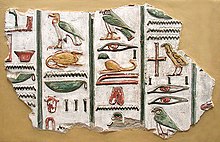| Egyptian hieroglyphs | |
|---|---|
 | |
| Type |
Logography usable as an abjad
|
| Languages | Egyptian language |
Time period
| c. 3200 BC[1][2][3] – AD 400[4] |
Parent systems
| |
Child systems
| Hieratic, Demotic, Coptic, Meroitic, Proto-Sinaitic |
| Direction | Left-to-right |
| ISO 15924 | Egyp, 050 |
Unicode alias
| Egyptian Hieroglyphs |
| |
Egyptian hieroglyphs /ˈhaɪrəɡlɪfs/[5][6] were the formal writing system used in Ancient Egypt. Hieroglyphs combined logographic, syllabic and alphabetic elements, with a total of some 1,000 distinct characters.[
At the root these logo grams were comprised of about 22 common things derived as pico raphs. The rest of the character is a phrase, with punctuation, plural, order, a closing line, royal stamp. They could be sequenced, sometimes three at a time.
But its core was the local venacular, one of the punctuation marks meant 'sounds like'. The default was the thing, it has a lurality markers, two; and so one. Any idiom could substitute its own local vernacular, and translate he hieroglyph to the local. A reverse dictionary.
Just unfold it, and you almost have Phoenician with including grammatical form. The Phoenicians discovered the trick, likely because they had better writing technology. But then, substitution by consonants, they would have a foreign dictionary format. A ready made pre-latin format. They must of had a cheaper, more durable version of writing material, one widely available to merchants. Vowels were an add on later. So I am looking there, in the bronze age collapse was their a sudden improvement in writing materials.
My first guess:
Parchment, unfoldng the hieroglyphs. They were the first traders with a foreign language format, and this occurred right at the switch to iron age. There is a lot of causality to sort out, but it seems a connected bundle to me.
My first guess:
The main way that the phoenicians wrote, was with very thin papyrus and an ink made from common plants and flowers (they would also occasionally write on stone tablets). This then disintegrated over time and so we do not have many pieces of writing from the phoenician time period. After a few years of writing on papyrus, the phoenicians then moved on to writing on parchment and wax-writing tablets.
Parchment, unfoldng the hieroglyphs. They were the first traders with a foreign language format, and this occurred right at the switch to iron age. There is a lot of causality to sort out, but it seems a connected bundle to me.
No comments:
Post a Comment